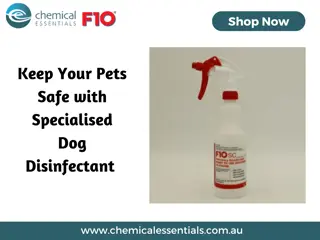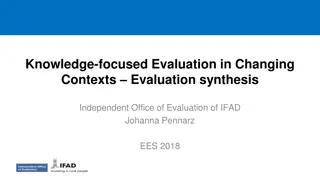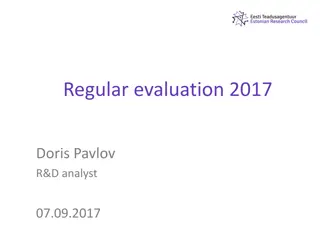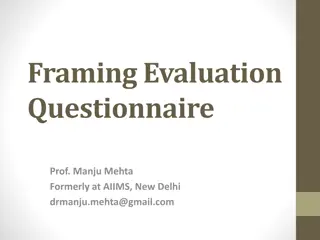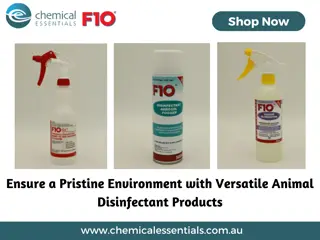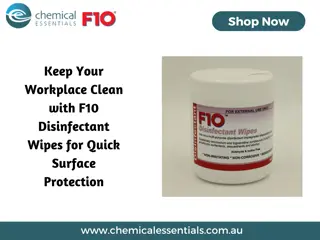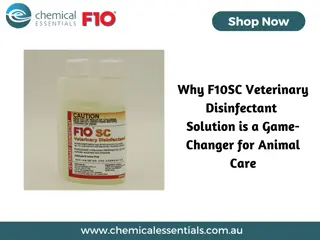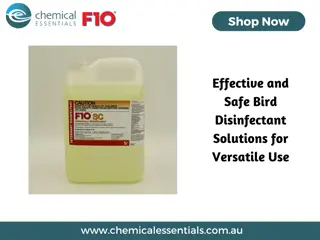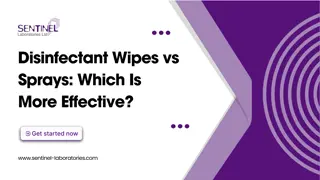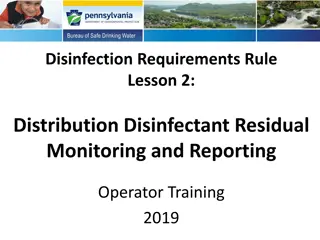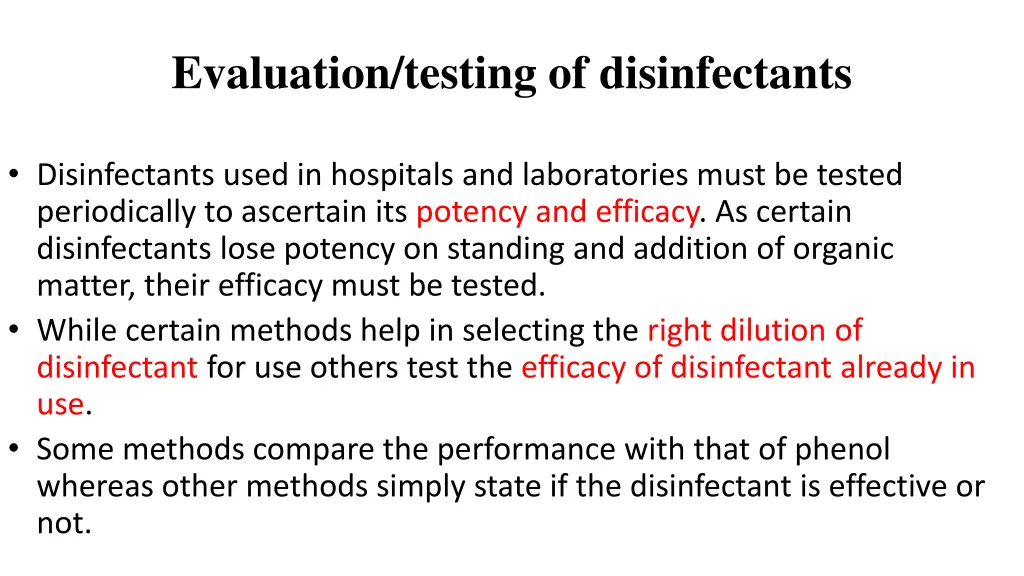
Evaluation Methods of Disinfectants in Hospitals and Laboratories
Learn about the importance of testing disinfectants for potency and efficacy, along with methods like Disk-Diffusion and Suspension tests. Understand how these evaluations help in selecting the right dilution of disinfectants and ensuring their effectiveness in combating bacteria.
Download Presentation

Please find below an Image/Link to download the presentation.
The content on the website is provided AS IS for your information and personal use only. It may not be sold, licensed, or shared on other websites without obtaining consent from the author. If you encounter any issues during the download, it is possible that the publisher has removed the file from their server.
You are allowed to download the files provided on this website for personal or commercial use, subject to the condition that they are used lawfully. All files are the property of their respective owners.
The content on the website is provided AS IS for your information and personal use only. It may not be sold, licensed, or shared on other websites without obtaining consent from the author.
E N D
Presentation Transcript
Evaluation/testing of disinfectants Disinfectants used in hospitals and laboratories must be tested periodically to ascertain its potency and efficacy. As certain disinfectants lose potency on standing and addition of organic matter, their efficacy must be tested. While certain methods help in selecting the right dilution of disinfectant for use others test the efficacy of disinfectant already in use. Some methods compare the performance with that of phenol whereas other methods simply state if the disinfectant is effective or not.
Disk-Diffusion Method Rideal Walker method Evaluation methods of Suspension tests (Phenol coefficient test) Disinfectants Chick Martin test Capacity test (Kelsey-Sykes test) In-use test (Kelsey Maurer test) Carrier tests
Disc of blotting paper impregnated with known volume and concentration of disinfectant is plate on a lawn culture of test bacteria. Disinfectant diffuses into the medium. After overnight incubation, the culture is examined for zones of inhibition
Uses & Advantages It can be useful in monitoring antimicrobials and for the selection of proper antibacterial agents. This test is used in determining the antibiotics of choice to treat an infection. It doesn t require special equipment to perform and can be interpreted by all medical personnel.
Suspension tests In these tests, a sample of the bacterial culture is suspended into the disinfectant solution and after exposure it is verified by subculture whether this inoculum is killed or not. There are different kinds of suspension tests: 1. the qualitative suspension tests, 2. the test for the determination of the phenol coefficient (Rideal and Walker, 1903) and 3. quantitative suspension tests. Initially this was done in a qualitative way. A loopful of bacterial suspension was brought into contact with the disinfectant and again a loopful of this mixture was cultured for surviving organisms. Results were expressed as growth or no growth . In quantitative methods, the number of surviving organisms is counted and compared to the original inoculum size.
Phenol coefficient test Historically, a chemical agent s effectiveness was often compared with that of phenol, the first chemical agent used by Joseph Lister. In 1903, British chemists Samuel Rideal and J. T. Ainslie Walker established a protocol to compare the effectiveness of a variety of chemicals with that of phenol, using as their test organisms Staphylococcus aureus (a gram-positive bacterium) and Salmonella enterica serovar Typhi (a gram-negative bacterium).
Phenol coefficient test A phenol coefficient of 1.0 means that the chemical agent has about the same level of effectiveness as phenol. A chemical agent with a phenol coefficient of less than 1.0 is less effective than phenol. An example is formalin, with phenol coefficients of 0.3 (S. aureus) and 0.7 (S. enterica serovar Typhi). A chemical agent with a phenol coefficient greater than 1.0 is more effective than phenol, such as chloramine, with phenol coefficients of 133 and 100, respectively. Although the phenol coefficient was once a useful measure of effectiveness, it is no longer commonly used because the conditions and organisms used were arbitrarily chosen
Determination of phenol coefficient: Phenol coefficient of a disinfectant is calculated by dividing the dilution of test disinfectant by the dilution of phenol that disinfects under predetermined conditions
Rideal Walker method 1. Phenol is diluted from 1:95 to 1:115 and the test disinfectant is diluted from 1:400 to 1:800. Their bactericidal activity is determined against Salmonella typhi suspension. 2. Subcultures are performed from both the test and phenol at intervals of 2.5, 5, 7.5 and 10 minutes. The plates are incubated for 48-72 hours at 37 C. 3. That dilution of disinfectant which disinfects the suspension in a given time is divided by that dilution of phenol which disinfects the suspension in same time gives its phenol coefficient
For example, after 7.5 minutes, the test organism was killed by the test disinfectant at a dilution of 1:600. In the same period the test organism was killed by phenol at a dilution of 1:100. ??? ???= ? This result indicates that the test disinfectant can be
Disadvantages of the Rideal-Walker test are: No organic matter is included. The time allowed for disinfection is short It should be used to evaluate phenolic type disinfectants only
Chick Martin test This test also determines the phenol coefficient of the test disinfectant. Unlike in Rideal Walker method where the test is carried out in water, the disinfectants are made to act in the presence of yeast suspension (or 3% dried human feces) to simulate the presence or organic matter. Time for subculture is fixed at 30 mins and the organism used to test efficacy is S.typhi as well as S.aureus
Capacity test (Kelsey-Sykes test) Each time a soiled instrument is placed into a container with disinfectant, a certain quantity of dirt and bacteria is added to the solution. The ability to retain activity in the presence of an increasing load is the capacity of the disinfectant. In a capacity test, the disinfectant is challenged repeatedly by successive additions of bacterial suspension until its capacity to kill has been exhausted. Capacity tests simulate the practical situations of housekeeping and instrument disinfection.
Capacity test (Kelsey-Sykes test) It is designed to determine concentrations of disinfectant that will be effective in clean and dirty conditions. The disinfectant is challenged by three successive additions of a bacterial suspension during the course of the test. The duration of test takes over 30 minutes to perform. Depending on the type of disinfectant, a single test organism is selected from S. aureus, P. aeruginosa, P. vulgaris and E. coli . The method can be carried out under 'clean' or 'dirty conditions. The dilutions of the disinfectant are made in hard water for clean conditions and in yeast suspension for dirty conditions. Test organism alone or with yeast is added at 0, 10 and 20 minutes interval. The contact time of disinfectant and test organism is 8 min
Capacity test (Kelsey-Sykes test) Capacity tests simulate the practical situations of housekeeping and instrument disinfection
Capacity test (Kelsey-Sykes test) The three sets of five replicate cultures corresponding to each challenge are incubated at 32 oC for 48 hours and growth is assessed by turbidity. The disinfectant is evaluated on its ability to kill microorganisms or lack of it and the result is reported as a pass or a fail and not as a coefficient. The capacity test of Kelsey and Sykes gives a good guideline for the dilution of the preparation to be used. Disadvantage of this test is the fact that it is rather complicated.
In-Use Test/KelseyMaurer test To determine whether an actively used solution of disinfectant in a clinical setting is microbially contaminated. A 1-mL sample of the used disinfectant is diluted into 9 mL of sterile broth medium that also contains a compound to inactivate the disinfectant. Ten drops, totaling approximately 0.2 mL of this mixture, are then inoculated onto each of two agar plates. One plate is incubated at 37 C for 3 days and the other is incubated at room temperature for 7 days. The plates are monitored for growth of microbial colonies. Growth of five or more colonies on either plate suggests that viable microbial cells existed in the disinfectant solution and that it is contaminated. Such in-use tests monitor the effectiveness of disinfectants in the clinical setting.
Carrier tests The test described by Robert Koch was a carrier test. In these tests, the carrier such as a silk or catgut thread is contaminated by submersion in a liquid culture of the test organism. The carrier is then dried and is brought in contact with the disinfectant for a given exposure time. After the exposure, it is cultured in a nutrient broth; no growth indicates activity of the disinfectant tested whereas growth indicates a failing.


